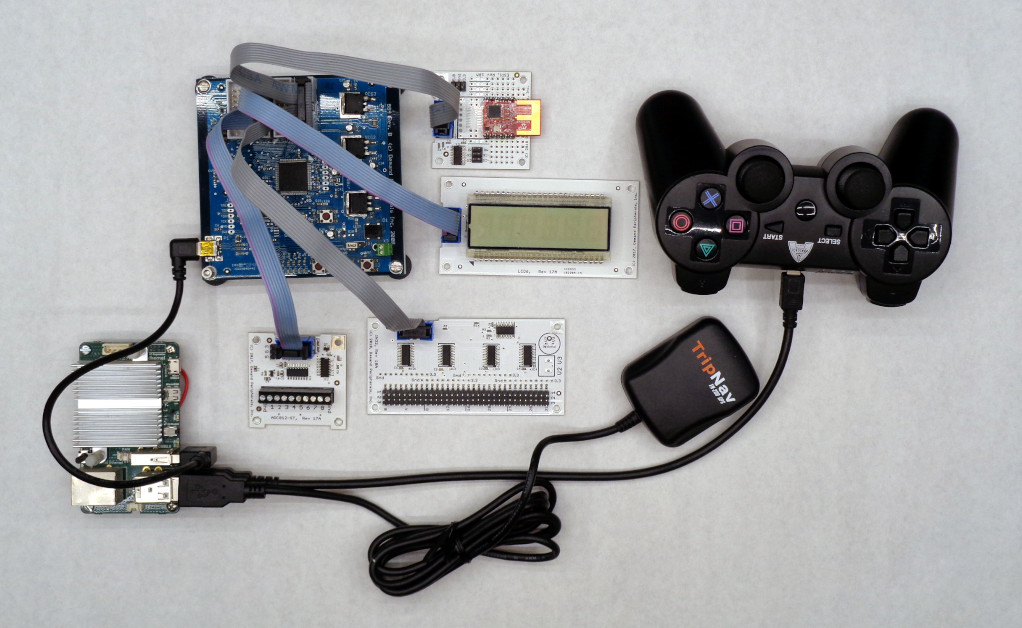FPGA based peripherals for user interface, sensors, and actuators.
DPCore is a set of Verilog peripherals implemented for a Demand Peripherals Baseboard FPGA card. The peripherals are written for the Xilinx Spartan family of FPGAs.
For each FPGA based peripheral there may be one or more dpdaemon peripherals. For example, the FPGA based enhanced SPI peripheral is the basis for the dpdaemon eSPI, RTC, AVR, DAC8, and QPOT peripherals. Please see the dpdaemon repository for more information about the Linux user-space interface and API.
For each FPGA based peripheral there may be one or more daughter cards that use the peripheral. For example, the OUT4 peripheral can control a quad relay card, a quad GPIO card, a quad USB hub card, or the quad open-drain driver card. Please see the DPI Hardware repository for more information about the available daughter cards.
This code is released under a dual license. In general it is free to use for personal projects but requires a license to use in a commercial product. See LICENSE.txt for licensing specifics.
The following diagram shows the major components in the Demand Peripherals system. Major components include: daughter cards, the FPGA card, dpdaemon, and your application. (The FPGA card supports eight daughter cards although this diagram shows only three.)
Dpdaemon is a set of user space device drivers implemented as plug-in modules. The daemon provides an ASCII API over TCP. The daemon also acts as a multiplexer for packets to and from the FPGA. The real functionality of dpdaemon is in a set of loadable shared object libraries (plug-ins). While intended to support the FPGA-based peripherals in a Demand Peripherals FPGA image, you may find that dpdaemon has several features you'll find useful for your next Linux-to-hardware project:
- Simple publish/subscribe mechanism for sensor data
- All commands and data are printable ASCII over TCP
- Only three commands in protocol: dpset, dpget, and dpcat
- Shell equivalents for all protocol commands
- Modular plug-ins (drivers) for easy development
- No dependencies (excluding libc)
- Event-driven and C gives a low CPU/memory footprint
- GPLv2 License.
DPCore is the FPGA part of the peripherals. DPCore has the timing and logic needed to drive the electronics on the daughter cards. For example, the FPGA part of the dc2 peripheral does the timing for the H-bridges that controls two DC motors. Logic in the FPGA implements an internal address and data bus and each peripheral has a set of 8-bit registers which configure the peripheral. For example, the FPGA peripheral part of dc2 has an 8-bit register that sets the mode (brake, coast, forward, or reverse) of each motor. Other registers in dc2 set the duty cycle of the H-bridge FETs and configure the watchdog timer.
The defining feature of the Demand Peripherals approach is that 32 of the FPGA pins are grouped into "slots" of exactly 4 pins each. The slots are completely interchangeable and any FPGA peripheral can attach to any slot. The use of ribbon cables makes it easy to attach any daughter card to any slot.
Daughter cards contain the electronic components needed. Daughter cards, called interface cards on the web site,might contain the sensors, H-Bridge FETs, or the headers to connect to servo motors. Each daughter card connects to the FPGA card over an eight-wire IDC cable connected to one slot. The cable has power lines and four pins from the FPGA. Daughter card designs are released under a Creative Commons license.
The picture below shows a typical system with a single board computer, an FPGA card, four daughter cards, and two dpdaemon managed USB peripherals.

